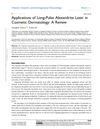Lasers for Dermatology and Skin Biology
TLDR Lasers have become precise tools in skin treatment and diagnosis, with ongoing advancements improving their effectiveness.
The document reviewed the evolution and applications of laser technology in dermatology and skin biology. Lasers, initially feared, became precise tools for treating conditions like port wine stains, rosacea, scars, and tattoos. Pulsed dye lasers were preferred for port wine stains, though challenges remained. Advances in pulse duration and cooling improved outcomes. Early laser hair removal failed, but later advancements led to effective hair reduction using millisecond pulses and lasers like Alexandrite and Nd:YAG. Fractional photothermolysis created microthermal damage zones for tissue remodeling without scarring, aiding in drug delivery and scar treatment. Laser microscopy techniques enhanced non-invasive imaging of skin structures, improving diagnostics and treatments. Future advancements in "smart" laser systems and imaging technologies were anticipated.



